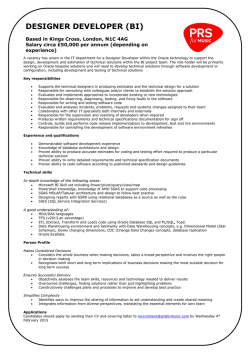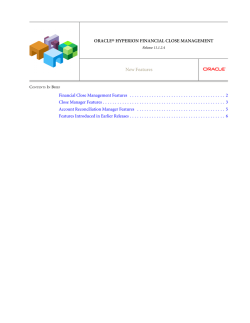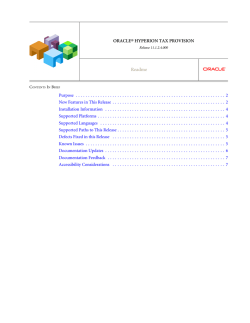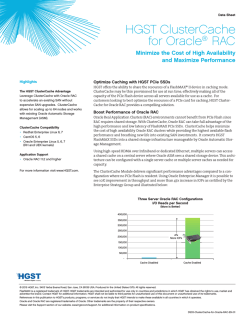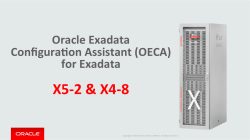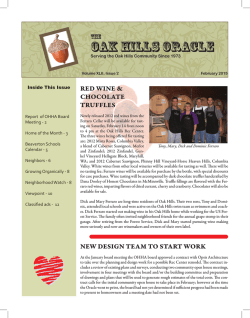
Cross-Site Load Balancing: Data Agility with Oracle Multitenant
Cross-Site Load Balancing: Data agility with Oracle Multitenant A Proof of Concept ORACLE WHITE PAPER | JANUARY 2015 Disclaimer The following is intended to outline our general product direction. It is intended for information purposes only, and may not be incorporated into any contract. It is not a commitment to deliver any material, code, or functionality, and should not be relied upon in making purchasing decisions. The development, release, and timing of any features or functionality described for Oracle’s products remains at the sole discretion of Oracle. CROSS SITE LOAD BALANCING: A PROOF OF CONCEPT Table of Contents Disclaimer 1 Description 2 Pre-requisites 4 Create a new PDB Cross-Site load balancing procedure 4 6 Ensure the PDB is closed on both primary and standby 6 Unplug the PDB from Primary1 6 Copy the XML Manifest to Site2 6 Create Aliases on OBELIX and OBELIX_STANDBY 6 Ensure Media Recovery is active on OBELIX_STANDBY 8 Plug PDB_XSTE in to OBELIX 9 Confirm PDB_XSTE was created on OBELIX_STANDBY 10 Open PDB_XSTE on OBELIX 11 Optionally delete PDB from original primary, ORCL 11 Conclusion 1 | CROSS SITE LOAD BALANCING: DATA AGILITY WITH ORACLE MULTITENANT A PROOF OF CONCEPT 13 Description A single standby database architecture has the primary database in Site A and the standby database in Site B. Active Data Guard allows the standby database to be opened read-only and used for reporting, ad-hoc queries and the like. There is no restriction as to where the primary and standby can be placed, and many customers will place the standby database on the same physical servers as the production (primary) instances of another database. The diagram below describes such a configuration, and is used as the basis for this proof of concept. Site A contains the production instance ORCL whose standby instance ORCL_STANDBY is on Site B. Site B contains the production instance OBELIX whose standby instance OBELIX_STANDBY is on Site A. ORCL and OBELIX are container databases containing several pluggable databases (PDBs). 2 | CROSS SITE LOAD BALANCING: DATA AGILITY WITH ORACLE MULTITENANT A PROOF OF CONCEPT Site A and Site B are both RAC clusters, though this is not strictly required for this proof of concept. Storage management at both sites is provided by ASM. The use of ASM allows for several optimizations in the cross-site operations, but as for RAC, ASM is not strictly required. It is conceivable to imagine that in a dynamic environment, where new PDBs are created, or workload requirements change, that load on a given site will increase to the extent that resources become scarce and the production database is impacted. The procedure outlined in this proof of concept shows how load on a site may be reduced by moving a PDB from Site A to Site B. This process could also apply to moving a given PDB such that more resources are available to it – if, for example, it was not meeting its service level agreement (SLA), or possibly during maintenance scenarios. 3 | CROSS SITE LOAD BALANCING: DATA AGILITY WITH ORACLE MULTITENANT A PROOF OF CONCEPT Pre-requisites In order to complete the procedure outlined in this document you will need to be able to connect to all of the database instances (both primaries and both standbys) with Oracle SQL*Plus, and if you will implement the optimization using ASM aliases, asmcmd. Requirements for transfer of PDBs (unplug and plug) between different CDBs must also be met. Create a new PDB Create a new PDB in the container ORCL. In this example we name the PDB: PDB_XSTE. [racuser@SITEA] $ORACLE_HOME/bin/sqlplus sys/[email protected]/orcl as sysdba SQL> create pluggable database PDB_XSTE admin user pdbxste identified by pdbxste roles=(connect, resource) tempfile reuse; Pluggable database created. SQL> show pdbs CON_ID --------2 3 … 23 CON_NAME ------------------PDB$SEED PDB1 OPEN MODE ---------READ ONLY READ WRITE PDB_XSTE MOUNTED RESTRICTED ---------NO NO NO SQL> alter pluggable database PDB_XSTE open Pluggable database altered SQL> show pdbs CON_ID CON_NAME --------- ------------------2 PDB$SEED 3 PDB1 … 23 PDB_XSTE OPEN MODE ---------READ ONLY READ WRITE RESTRICTED ---------NO NO READ WRITE NO The standby site, SITE B, will show corresponding information [racuser@SITEB] $ORACLE_HOME/bin/sqlplus sys/[email protected]/orcl_standby as sysdba SQL> show pdbs CON_ID --------2 3 … 23 CON_NAME ------------------PDB$SEED PDB1 OPEN MODE ---------READ ONLY READ WRITE PDB_XSTE MOUNTED RESTRICTED ---------NO NO NO Identify the datafiles associated with the PDB PDB_XSTE on both the primary and the standby: 4 | CROSS SITE LOAD BALANCING: DATA AGILITY WITH ORACLE MULTITENANT A PROOF OF CONCEPT [racuser@SITEA] $ORACLE_HOME/bin/sqlplus sys/[email protected]/orcl as sysdba SQL> select name from v$datafile where con_id = 23; NAME -------------------------------------------------------------------------------+RWSBIJ1314_DATA_DG/ORCL/0570BC129DBE51BBE053F501D10A9471/DATAFILE/system.581.86 0972039 +RWSBIJ1314_DATA_DG/ORCL/0570BC129DBE51BBE053F501D10A9471/DATAFILE/sysaux.758.86 0972041 [racuser@SITEB] $ORACLE_HOME/bin/sqlplus sys/[email protected]/orcl_standby as sysdba SQL> select name from v$datafile where con_id = 23; NAME -------------------------------------------------------------------------------+RWSBIJ1314_DATA_DG/ORCL_STANDBY/0570BC129DBE51BBE053F501D10A9471/DATAFILE/syste m.755.860972045 +RWSBIJ1314_DATA_DG/ORCL_STANDBY/0570BC129DBE51BBE053F501D10A9471/DATAFILE/sysau x.588.860972047 5 | CROSS SITE LOAD BALANCING: DATA AGILITY WITH ORACLE MULTITENANT A PROOF OF CONCEPT Cross-Site load balancing procedure Ensure the PDB is closed on both primary and standby [racuser@SITEA] $ORACLE_HOME/bin/sqlplus sys/[email protected]/orcl as sysdba SQL> alter pluggable database PDB_XSTE close; Pluggable database altered. SQL> show pdbs CON_ID --------2 3 … 23 CON_NAME ------------------PDB$SEED PDB1 OPEN MODE ---------READ ONLY READ WRITE PDB_XSTE MOUNTED RESTRICTED ---------NO NO NO Unplug the PDB from Primary1 [racuser@SITEA] $ORACLE_HOME/bin/sqlplus sys/[email protected]/orcl as sysdba SQL> alter pluggable database pdb_xste unplug into 2 '/scratch/oracle/oracle_base/dbhome/dbs/pdb_xste.xml'; Pluggable database altered. Copy the XML Manifest to SiteB [racuser@SITEA] scp /scratch/oracle/oracle_base/dbhome/dbs/pdb_xste.xml racusr@SITEB: /scratch/oracle/oracle_base/dbhome/dbs/pdb_xste.xml [racusr@SITEA] Create Aliases on OBELIX and OBELIX_STANDBY We will be moving the PDB to a different primary database container. In our configuration the original standby and the other primary are on the same server, and use the same ASM diskgroups. We can eliminate the need to transfer files (to the new primary site) as they are already present, albeit as part of the old standby. 6 | CROSS SITE LOAD BALANCING: DATA AGILITY WITH ORACLE MULTITENANT A PROOF OF CONCEPT We are using Oracle-Managed Files with this configuration, which means the full path names to the database files contain the database name. ASM identifies the files associated with a database through the disk and file header information. The pathname is a logical construct, and does not clearly identify which database a given datafile belongs to. This can be confusing to DBAs and other humans.Therefore when we create the aliases in this section we will also change the path to better represent the database these files are now part of. In order for the redo apply service to continue to operate an alias has to be created. On the new primary instance, OBELIX, create an alias that points to files on ORCL_STANDBY: First, add path entries with asmcmd for the OBELIX database on Site B, and then connect to the ASM instance to add the alias to the diskgroup: [racuser@SITEB] export ORACLE_SID=+ASM2 [racusr@SITEB] export ORACLE_HOME=/scratch/oracle/12.1.0/grid [racusr@SITEB]$ $ORACLE_HOME/bin/asmcmd ASMCMD> cd +RWSBIJ1314_DATA_DG ASMCMD> cd OBELIX ASMCMD> mkdir 0570BC129DBE51BBE053F501D10A9471 ASMCMD> cd 0570BC129DBE51BBE053F501D10A9471 ASMCMD> mkdir DATAFILE ASMCMD> cd DATAFILE ASMCMD> ls ASMCMD> quit [racusr@SITEB]$ $ORACLE_HOME/bin/sqlplus sys/oracle as sysasm SQL> alter diskgroup RWSBIJ1314_DATA_DG add alias '+RWSBIJ1314_DATA_DG/OBELIX/0570BC129DBE51BBE053F501D10A9471/DATAFILE/system_755_8609 72045' FOR '+RWSBIJ1314_DATA_DG/ORCL_STANDBY/0570BC129DBE51BBE053F501D10A9471/DATAFILE/system.75 5.860972045'; Diskgroup altered. SQL> alter diskgroup RWSBIJ1314_DATA_DG add alias '+RWSBIJ1314_DATA_DG/OBELIX/0570BC129DBE51BBE053F501D10A9471/DATAFILE/sysaux_588_8609 72047' FOR '+RWSBIJ1314_DATA_DG/ORCL_STANDBY/0570BC129DBE51BBE053F501D10A9471/DATAFILE/sysaux.58 8.860972047'; Diskgroup altered. SQL> quit The datafile path corresponds to that which we read from the standby site earlier. The alias name has the same path, except that underscores (“_”) have replaced periods (“.”) in the file names, and we replaced the standby database name (ORCL_STANDBY) with the new primary name (OBELIX). Now we create aliases for the new standby instance (OBELIX_STANDBY) on Site A. 7 | CROSS SITE LOAD BALANCING: DATA AGILITY WITH ORACLE MULTITENANT A PROOF OF CONCEPT [racuser@SITEA] export ORACLE_SID=+ASM1 [racusr@SITEA] export ORACLE_HOME=/scratch/oracle/12.1.0/grid [racusr@SITEB]$ $ORACLE_HOME/bin/asmcmd ASMCMD> cd +RWSBIJ1314_DATA_DG ASMCMD> cd OBELIX_STANDBY ASMCMD> mkdir 0570BC129DBE51BBE053F501D10A9471 ASMCMD> cd 0570BC129DBE51BBE053F501D10A9471 ASMCMD> mkdir DATAFILE ASMCMD> cd DATAFILE ASMCMD> ls ASMCMD> quit [racusr@SITEB]$ $ORACLE_HOME/bin/sqlplus sys/oracle as sysasm SQL> alter diskgroup RWSBIJ1314_DATA_DG add alias '+RWSBIJ1314_DATA_DG/OBELIX_STANDBY/0570BC129DBE51BBE053F501D10A9471/DATAFILE/system_ 755_860972045' FOR '+RWSBIJ1314_DATA_DG/ORCL/0570BC129DBE51BBE053F501D10A9471/DATAFILE/system.581.860972 039'; Diskgroup altered. SQL> alter diskgroup RWSBIJ1314_DATA_DG add alias '+RWSBIJ1314_DATA_DG/OBELIX_STANDBY/0570BC129DBE51BBE053F501D10A9471/DATAFILE/sysaux_ 588_860972047' FOR '+RWSBIJ1314_DATA_DG/ORCL/0570BC129DBE51BBE053F501D10A9471/DATAFILE/sysaux.758.860972 041'; Diskgroup altered. SQL> quit Note that the alias names in the standby use the filenames recently created on the new primary. In this example this corresponds to the names containing the underscores, that is system_755_860972045. The aliases created for these files point to files that belong to the original primary, ORCL. Ensure Media Recovery is active on OBELIX_STANDBY Before plugging the PDB in to the new primary, OBELIX, ensure that the Media Recovery Process is active on the OBELIX_STANDBY instance: 8 | CROSS SITE LOAD BALANCING: DATA AGILITY WITH ORACLE MULTITENANT A PROOF OF CONCEPT [racuser@SITEA] export ORACLE_SID=obelix_standby1 [racusr@SITEA] export ORACLE_HOME=/scratch/oracle/oracle_base/dbhome [racusr@SITEA]$ $ORACLE_HOME/bin/sqlplus sys/[email protected]/obelix_standby as sysdba SQL> set lines 120 SQL> set pages 9999 SQL> select * from v$managed_standby where process='MRP0'; PROCESS PID STATUS CLIENT_P CLIENT_PID --------- ------------------------ ------------ -------- --------------------------------------CLIENT_DBID GROUP# RESETLOG_ID THREAD# SEQUENCE# ---------------------------------------- ---------------------------------------- ---------- ---------- ---------BLOCK# BLOCKS DELAY_MINS KNOWN_AGENTS ACTIVE_AGENTS CON_ID ---------- ---------- ---------- ------------ ------------- ---------MRP0 13359 APPLYING_LOG N/A N/A N/A N/A 854748558 1 836 43146 204800 0 25 25 0 If the MRP0 process is not running, examine the alert log and/or trace files as to why it has stopped. Plug PDB_XSTE in to OBELIX Plugin the PDB_XSTE on OBELIX primary using the directive source_file_directory=<Full directory of OBELIX primary datafile location> The PLUG operation will use the location specified in the path source_file_directory to search for the datafiles with which to create the pluggable database. The file names will not exist, but the header information stored in the XML manifest can be used to match the actual files. On the standby site the MRP process will look for files in the default location (<diskgroup_name/db_unique_name/guid/DATAFILE>) and again try to macth files based on header information passed in the redo stream. 9 | CROSS SITE LOAD BALANCING: DATA AGILITY WITH ORACLE MULTITENANT A PROOF OF CONCEPT [racuser@SITEB] $ORACLE_HOME/bin/sqlplus sys/[email protected]/obelix as sysdba SQL> create pluggable database PDB_XSTE using 2 '/scratch/oracle/oracle_base/dbhome/dbs/pdb_xste.xml' 3 source_file_directory='+RWSBIJ1314_DATA_DG/OBELIX/0570BC129DBE51BBE053F501D10A9471/DA TAFILE' tempfile reuse 4 nocopy; Pluggable database created. SQL> show pdbs CON_ID CON_NAME OPEN MODE ---------- ------------------------------ ---------2 PDB$SEED READ ONLY 3 PDB1 READ WRITE ... 18 PDB_XSTE MOUNTED SQL> select name from v$datafile where con_id=18; RESTRICTED ---------NO NO NAME -------------------------------------------------------------------------------+RWSBIJ1314_DATA_DG/OBELIX/0570BC129DBE51BBE053F501D10A9471/DATAFILE/system_755_ 860972045 +RWSBIJ1314_DATA_DG/OBELIX/0570BC129DBE51BBE053F501D10A9471/DATAFILE/sysaux_588_ 860972047 Confirm PDB_XSTE was created on OBELIX_STANDBY [racuser@SITEA] $ORACLE_HOME/bin/sqlplus sys/[email protected]/obelix_standby as sysdba SQL> show pdbs CON_ID CON_NAME OPEN MODE ---------- ------------------------------ ---------2 PDB$SEED READ ONLY 3 PDB1 READ WRITE ... 18 PDB_XSTE MOUNTED SQL> select name from v$datafile where con_id=18; RESTRICTED ---------NO NO NAME -------------------------------------------------------------------------------+RWSBIJ1314_DATA_DG/OBELIX_STANDBY/0570BC129DBE51BBE053F501D10A9471/DATAFILE/system_7 55_860972045 +RWSBIJ1314_DATA_DG/OBELIX_STANDBY/0570BC129DBE51BBE053F501D10A9471/DATAFILE/sysaux_5 88_860972047 10 | CROSS SITE LOAD BALANCING: DATA AGILITY WITH ORACLE MULTITENANT A PROOF OF CONCEPT Open PDB_XSTE on OBELIX The PDB can now be opened READ WRITE on the new primary, OBELIX, and READ ONLY on OBELIX_STANDBY. On SITE2 [racuser@SITEB] $ORACLE_HOME/bin/sqlplus sys/[email protected]/obelix as sysdba SQL> alter session set container=pdb_xste; Session altered. SQL> startup restrict Pluggable Database opened. SQL> show pdbs CON_ID CON_NAME OPEN MODE RESTRICTED ---------- ------------------------------ ---------- ---------18 PDB_XSTE READ WRITE YES SQL> exec dbms_pdb.sync_pdb(); PL/SQL procedure successfully completed. SQL> alter system disable restricted session; System altered. SQL> show pdbs CON_ID CON_NAME OPEN MODE RESTRICTED ---------- ------------------------------ ---------- ---------18 PDB_XSTE READ WRITE NO On SITE1 [racuser@SITEA] $ORACLE_HOME/bin/sqlplus sys/[email protected]/obelix_standby as sysdba SQL> alter session set container=pdb_xste; Session altered. SQL> alter pluggable database pdb_xste open read only; Pluggable database altered. SQL> alter tablespace temp add tempfile; Tablespace altered. SQL> show pdbs CON_ID CON_NAME OPEN MODE RESTRICTED ---------- ------------------------------ ---------- ---------18 PDB_XSTE READ ONLY NO Optionally delete PDB from original primary, ORCL 11 | CROSS SITE LOAD BALANCING: DATA AGILITY WITH ORACLE MULTITENANT A PROOF OF CONCEPT The PDB can now be dropped from the ORCL database, remembering to KEEP the datafiles, as they are now associated with the database OBELIX_STANDBY. [racuser@SITEA] $ORACLE_HOME/bin/sqlplus sys/[email protected]/orcl as sysdba SQL> drop pluggable database pdb_xste keep datafile; Pluggable database dropped. SQL> show pdbs CON_ID ---------2 3 ... 22 CON_NAME -----------------------------PDB$SEED PDB1 OPEN MODE ---------READ ONLY READ WRITE PDB20 MOUNTED RESTRICTED ---------NO NO 12 | CROSS SITE LOAD BALANCING: DATA AGILITY WITH ORACLE MULTITENANT A PROOF OF CONCEPT Conclusion This proof-of-concept shows that load balancing across sites is possible using a combination of Oracle Multitenant and Oracle Data Guard. When coupled with the flexibility offered by Oracle Real Application Clusters for local site management it is a complete demonstration of the agility and flexibility required by those customers offering Database as a Service. 13 | CROSS SITE LOAD BALANCING: DATA AGILITY WITH ORACLE MULTITENANT A PROOF OF CONCEPT Oracle Corporation, World Headquarters Worldwide Inquiries 500 Oracle Parkway Phone: +1.650.506.7000 Redwood Shores, CA 94065, USA Fax: +1.650.506.7200 CONNECT W ITH US blogs.oracle.com/oracle facebook.com/oracle twitter.com/oracle oracle.com Copyright © 2014, Oracle and/or its affiliates. All rights reserved. This document is provided for information purposes only, and the contents hereof are subject to change without notice. This document is not warranted to be error-free, nor subject to any other warranties or conditions, whether expressed orally or implied in law, including implied warranties and conditions of merchantability or fitness for a particular purpose. We specifically disclaim any liability with respect to this document, and no contractual obligations are formed either directly or indirectly by this document. This document may not be reproduced or transmitted in any form or by any means, electronic or mechanical, for any purpose, without our prior written permission. Oracle and Java are registered trademarks of Oracle and/or its affiliates. Other names may be trademarks of their respective owners. Intel and Intel Xeon are trademarks or registered trademarks of Intel Corporation. All SPARC trademarks are used under license and are trademarks or registered trademarks of SPARC International, Inc. AMD, Opteron, the AMD logo, and the AMD Opteron logo are trademarks or registered trademarks of Advanced Micro Devices. UNIX is a registered trademark of The Open Group. 0115 White Paper Title: Cross Site Load Balancing: Data agility with Oracle Multitenant, A proof of concept January 2015 Author: Silviu Teodoru Contributing Authors: Troy Anthony, Frank Kobylanski, Ciprian Pustianu 14 | CROSS SITE LOAD BALANCING: DATA AGILITY WITH ORACLE MULTITENANT A PROOF OF CONCEPT
© Copyright 2025
